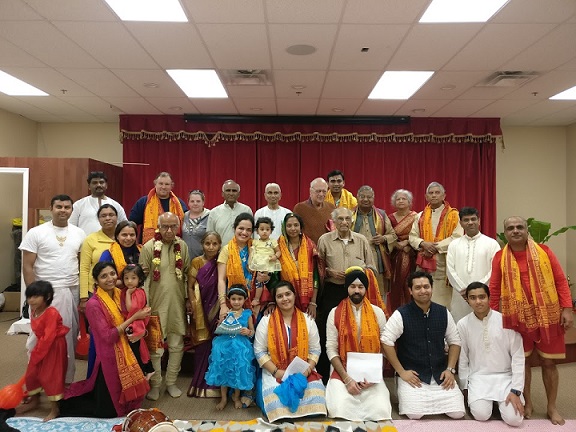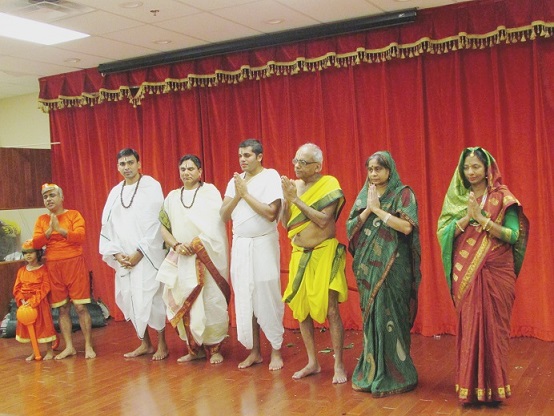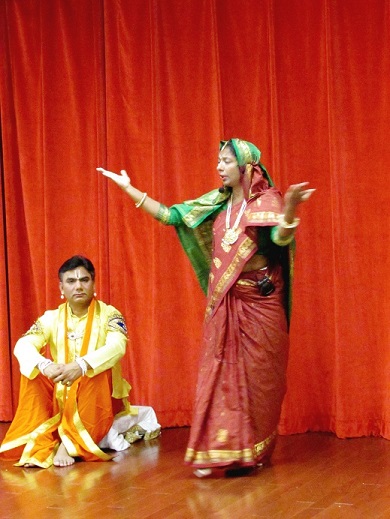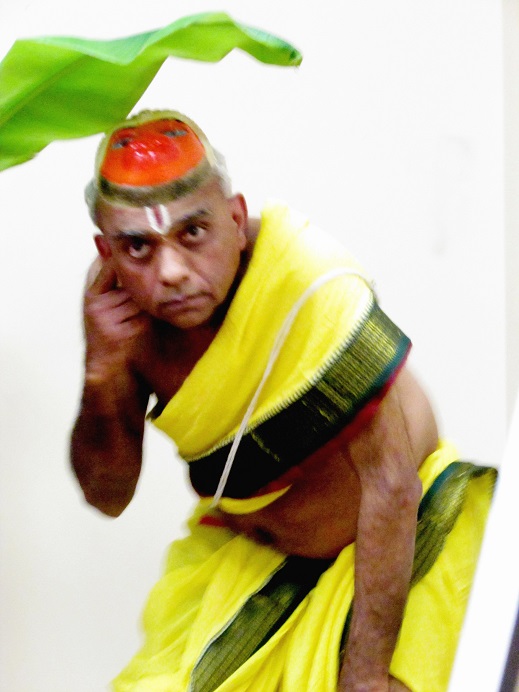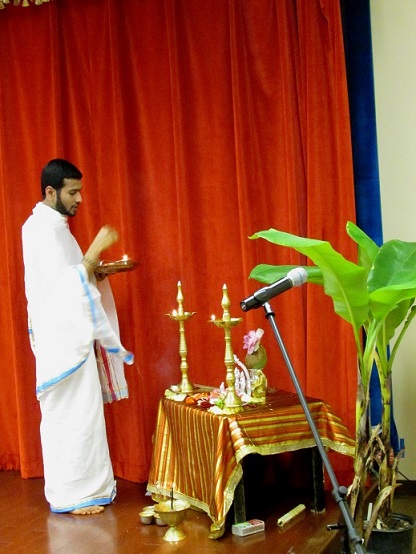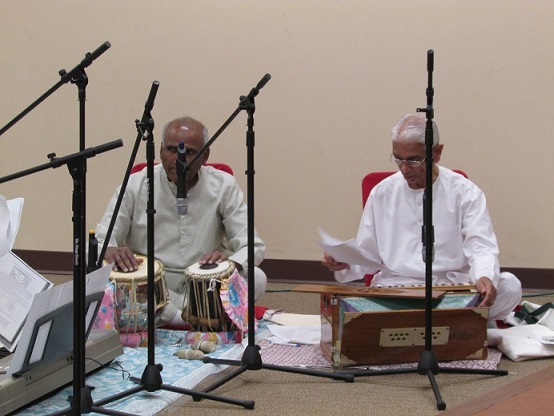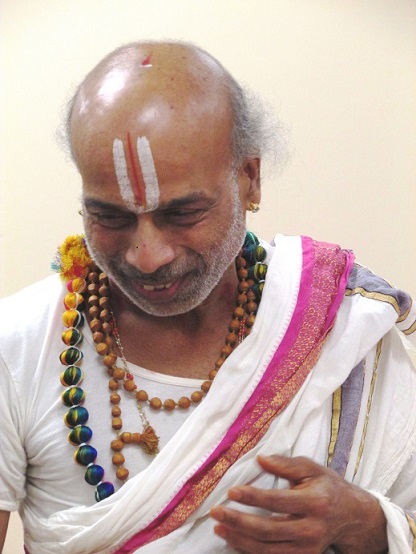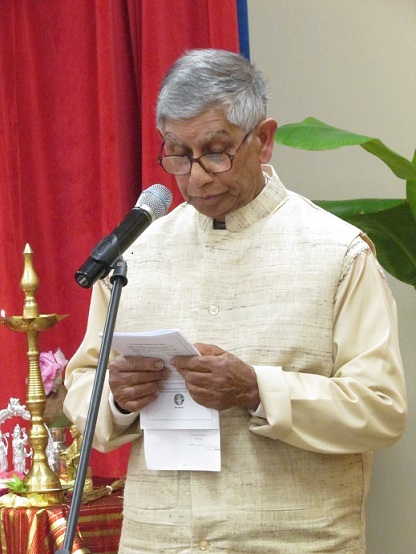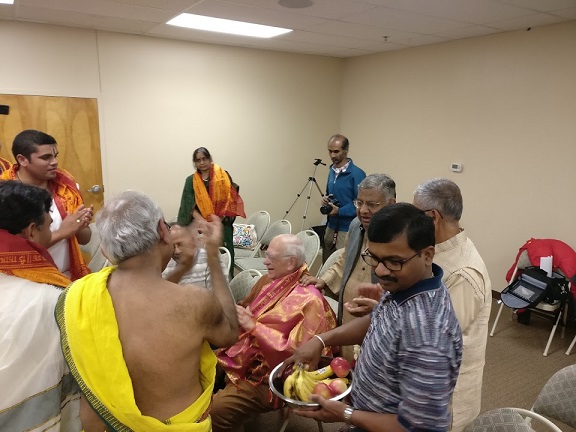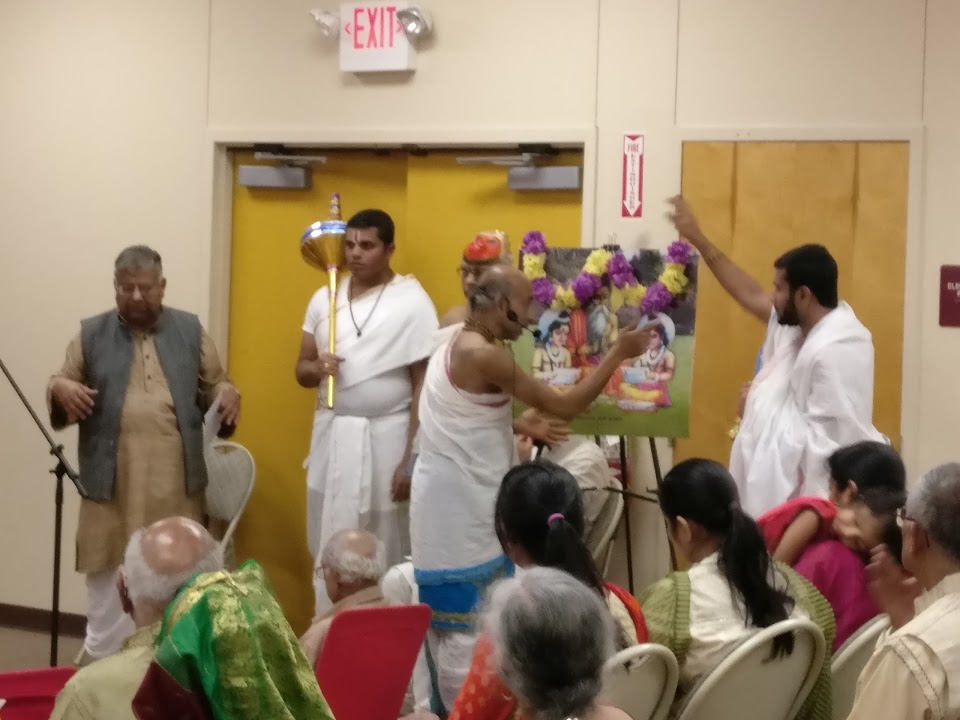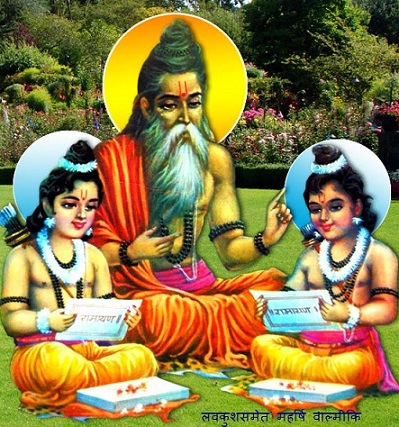Contribute
| Valmiki Jayanti At Shri Dwarkamai Vidyapeeth |
Anita Hukamchand and Bijoy Misra
10/26/2016
Composed by
the Sage Valmiki about two thousand years ago, the epic of Ramayana has served
as the basic reference in Indian society as a model of human conduct and
values. Not much is known about the poet
himself, except a later legend suggesting that he was transformed to creative
writing from an early profession of robbery. The Ramayana’s popularity is most
likely due to its detailed analysis of human emotions in poetic simulation of
everyday life played out in the life of Sri Rama, his wife Sita, his parents,
his step-mothers, his enemies and his friends.
The poet helps create the message that a righteous life gets its reward
however delayed. The epic calls for hopefulness
and aspiration during phases of seemingly difficult treads in life. The book and the story form the major cultural
tradition in India as well as the countries in South East Asia like Thailand,
Cambodia, Vietnam and Indonesia. Valmiki’s Ramayana is considered the earliest literary poetic
composition in India. It continues to
maintain its living tradition through performing arts, festivals, poetic
readings and social as well as religious discourse. In later times, Sri Rama has been elevated to
be a divine personality and accepted as a deity in Hindu religious
practice. Thus the book of Ramayana is
also given its divine status in the Hindu home and society. Following this tradition, the poet Valmiki is
accepted as a Hindu Saint and is accorded the respect and divinity for his
creativity and the genius. Through astronomical calculations, Valmiki’s
birthday is observed on the full moon day of the month of Ashvina in Hindu calendar. On the Full Moon Day on October 15, the
Dwarkamai Vidyapeeth helped celebrate Valmiki Jayanti with a special tribute
and presentation of musical enactments of three episodes from Valmiki’s
Ramayana. The event was held in the
annex hall from 4 PM to 6 PM. About a
hundred people from various walks of life attended the event. Though considered a living tradition, there is no historical
narrative how the poetic composition managed to enter the social life of the
population. One can infer from the book
that Valmiki was musically inclined and wanted his composition to be sung in
public. He taught the musical rendition
of the composition to two of his students, Lava and Kusha, who popularized the
story rendering it in public. One also
observes the dramatic turn of events in the composition making it an
interesting lyric of play of words in creating an ambiance in generating
emotion. Affecting human emotion through
the creativity of poetic composition is the hallmark of the genius of Valmiki. Dr. Bijoy Misra of Harvard University initiated a Valmiki
Reading Program in Dwarkamai Vidyapeeth in May of 2013. Ramayana books were procured from the Gita
Press in India and the group was convened to meet twice a month on Sundays from
3 PM to 5:30 PM. The program continues https://www.dwarkamai.com/vidyapeeth/events. A Sanskrit tutorial class was begun in 2014
to help create better recitation quality and understanding in Sanskrit
grammar. The class notes are available
at https://sanskritdiscussion.wordpress.com/. The Sanskrit Study Group helped in hosting
the first anniversary of reading of Valmiki Ramayana in May of 2014. http://www.lokvani.com/lokvani/article.php?article_id=10172. In May 2015, the group hosted a theatrical
rendition using Valmiki’s text. The
characters of Dasaratha, Kaushalya, Bharata, Lakshmana and Rama were
individually presented. http://www.lokvani.com/lokvani/article.php?article_id=11056 It was decided that 2016 would be dedicated to a formal
celebration of Valmiki Jayanti, to pay a cultural tribute to the poet
theatrically and musically. Three
episodes were selected and edited to help create a musical play. Dr. Ravi Mosurkal of Chinmaya Mission
volunteered to compose the music for the selected stanzas. Mrs. Srilakshmi Srinivasan assisted in adding
voice to the composition. A chorus team
was selected with Mrs. Purnima Prabhu as the leader. Ms. Roshini Saluja, Mr. Baldeep Gandhi and
Mr. Ajay Kewale joined as team members in the chorus. Mr. Balubhai Patel and Mr. Ramanbhai Patel
from the Satsang Center joined as the band leaders for the orchestra. Mr. Moolraj Mathur joined the orchestra on
manjira. Mr. Sanjeev Tripathi played the
role of Sri Rama, Mr. Raviteja Varanasi played the role of Lakshmana, Ms.
Srilakshmi Srinivasan played the role of Kaushalya, Mr. Vrittamani Ramapriya
played the role of Sugriva, Mr. Janmejay Shishupal played the role of Hanuman
and Ms. Bhavani Vankineni played the role of Tara. Associates of Sugriva were played by Mr. Anil
Naik, Mr. Braj Sharma, Mr. Ashish Tripathi, Mr. Abhishek Tripathi and the baby
star Mr. Nihal Bhav Dasari. The costumes and the makeup were facilitated by Mrs.
Anita Hukamchand. The invocation music was led by Dr. Ravi Mosurkal and Mr.
Raghuram Bhattar offered the worship at the shrine. “Srimad Ramayana is like a Ganga arising
from Valmiki Mountains accompanied with the waters of Sri Rama. The thought and sound of it leads one to
liberation!†The orchestra and
chorus played excellent to the tunes.
The play scenes were presented with Jatra style music creating a joyous
atmosphere attempting to simulate a possible social assembly two thousand years
ago! Mr. Balubhai Patel and Mr.
Ramanbhai Patel were excellent in their work. The first scene depicted Kaushalya’s motherly blessings to
her son as the latter left for the long sojourn to the forest. Kaushalya first dissuaded Sri Rama not to
subject himself to a difficult adventure.
Finding Sri Rama determined to follow his father’s orders, Kaushalya
felt helpless. She tried to consolidate
herself with her spiritual energy and showered her benediction at Sri Rama with
emotion and prayers. “I would not be
there with you physically in the forest, but gods will be. I have worshipped them before. I have confidence in them. They would protect you. Please return back healthy and fulfilled.†Mrs. Srilakshmi Srinivasan played the role of
Kaushalya with emotion and passion drawing applause from the audience. The second scene was about Sri Rama and Lakshmana meeting
Sugriva and Hanuman in the forests of Kiskindha. A scared Sugriva hiding from his brother Vali
had taken shelter in the Rshyamuka Mountains. Ever vigilant, he noticed Sri
Rama and Lakshmana wandering near the Pampa Lake. He asked his Minister Hanuman to check them
out. Hanuman presented himself in the
guise of a hermit and greeted them in chaste Sanskrit. Sri Rama was impressed and advised Lakshmana
to make an introduction. Hanuman learned
that the brothers had made the trek to meet Sugriva in search of Sita, the
abducted wife of Sri Rama. He escorted
them to Sugriva’ abode where the latter was delighted to meet them. “Please extend your hand and hold mine
together if you wish to join in friendship.†Hanuman lighted a fire. Sri Rama and Sugriva circumambulated the fire
in order to sanctify their new relationship.
Sugriva expressed his grief of his own wife being confined by his
brother Vali. Rama made the valiant cry “My
arrows will be directed at all miscreants. They will be killed. Your brother
will fall like a mountain!†Sugriva
stole the show with his free delivery and natural mimicry. Sri Rama, Lakshmana and Hanuman played their
roles equally well. The third scene presented Tara’s grief at Vali’s death. Vali was killed by Sri Rama. The monkeys in the forest were scared. They wanted
Tara to create a quick succession in order to restore order. Tara lost her composure and wailed hard
hugging the body of her husband. “O’ great
Lord, why are you not speaking to me?
Why are you lying down on the ground?
Have you accepted the ground as a better consort than me? Please rise!
I miss you bad!†Hanuman
consoled her by sharing the wisdom that “Life is transitory like a bubble. Please think ahead and not of the past. Please think of your responsibility to your
son.†Tara would not listen. “I can get a hundred sons, but not a
husband! Nothing else would give me more happiness than to sleep at my
husband’s feet!†Ms. Bhavani
Vankineni as Tara was excellent in her rendition. Pandit Krishna Bhattar, the Head priest at Srilakshmi Temple
in Ashland, joined the event as the Guest of Honor and helped inaugurate the
Valmiki portrait made especially for the occasion. Coming from a Vaishnava tradition, Pandit
Bhattar has been a regular reader of the text and a firm believer in the
sanctity of Sri Rama. After a short
speech by him, a tribute to Valmiki was paid on behalf of the people of India
through a poem written by the national poet Rabindranath Tagore. The poem in Bengali was extracted from a
drama “Valmiki Pratibha†that was written by poet Rabindranath. The character of Valmiki was enacted by
him. The poem was read by Mr. Alok De of
Cambridge. Mr. Surendrabhai Vaidya from
the Valmiki Reading Group followed with a short observation of the functioning
of the group. He recited a few stanzas
in his melodious voice. In the concluding part of the program, a prayer was offered
by Mr. Moolraj Mathur, the ninety year old activist and artist in the
community. Dr. Misra thanked all for
their efforts and recognized his friend Mr. Thomas Burke from Harvard
University who has been instrumental in popularizing Sanskrit studies in the
University. Now in his early 80’s, Mr.
Burke served the Benares Sanskrit College in the ‘60s. Dr. Misra also
recognized Mr. Prabhulal Rathi, also at 80, who initiated the recitation of
Ramayana in Hindi in the Boston area.
All were felicitated by Mr. Anil Naik, the principal organizer at
Dwarkamai, with the gift of flowers and a Sai Shawl. Dr. Misra was presented with a special plaque
for his efforts in helping to create the Valmiki event. Mr. Suresh Pillappa and Mr. Ajay Kewale helped with the P/A
Systems. The pictures are the courtesy
of Mr. Chou Chin Chung and Mr. Rajesh Prabhu.
Mr. Kevin Voisine helped to record the program in video. Mr. Sandeep Srivastava helped with the
location logistics and printing of the program brochure. Mr. Raviteja Varanasi helped in procuring the
Valmiki image and getting it printed in time for the event. The participants thanked them for their
support. It was an afternoon of exploration of creative music in
helping to recreate a tradition which might have been in practice in old
India. All participants and the
attendees were happy with the efforts and many teared in joy. All were treated to prasada on behalf the
Dwarkamai. The group planned to
reconvene for another production in 2017.
Let Sai bless all.
You may also access this article through our web-site http://www.lokvani.com/
